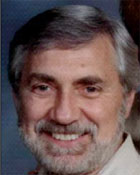 Charles Mistretta, Ph.D., who has pioneered outstanding advances in vascular imaging, was honored in late November when he was awarded the 2016 Institute of Electrical and Electronic Engineering (IEEE) Medal for Innovations in Healthcare Technology. The annual award, with recipients selected by the IEEE Board of Directors, is given for outstanding contributions to or innovations in engineering within the fields of medicine, biology, and healthcare technology.
Charles Mistretta, Ph.D., who has pioneered outstanding advances in vascular imaging, was honored in late November when he was awarded the 2016 Institute of Electrical and Electronic Engineering (IEEE) Medal for Innovations in Healthcare Technology. The annual award, with recipients selected by the IEEE Board of Directors, is given for outstanding contributions to or innovations in engineering within the fields of medicine, biology, and healthcare technology.
Dr. Mistretta earned this award for his development of imaging instrumentation and techniques that have transformed the diagnosis and treatment of vascular diseases. His first major contribution to the field was leading the research team that developed digital subtraction angiography (DSA) in 1971.
“Chuck Mistretta is very deserving of this prestigious award, because through his development of highly advanced imaging techniques now used around the world, he has had a profound impact on how healthcare is delivered to millions of people,” said Robert N. Golden, dean of the UW School of Medicine and Public Health. “He is an exceptional example of how we at the university are constantly pursuing and realizing the Wisconsin Idea.”
In addition to DSA, Dr. Mistretta’s many contributions to the field include Time Resolved Imaging of Contrast KineticS (TRICKS), a three-dimensional, time-resolved imaging technique used to diagnose blood clots and other vascular problems. Patented in 1996, TRICKS is still the gold standard in vascular imaging.
Mistretta earned his doctorate in high-energy physics from Harvard University in 1968 and joined the University of Wisconsin faculty in 1971. His pioneering research in time-resolved angiography has led to significant improvements in the effectiveness, speed, and image quality of magnetic resonance imaging, X-ray computed tomography, and interventional X-ray imaging. Dr. Mistretta holds 43 U.S. patents, is a member of the National Academy of Engineering, and is a fellow of the American Institute for Medical and Biological Engineering.